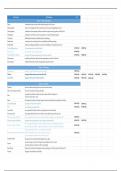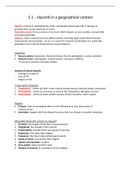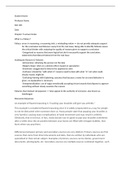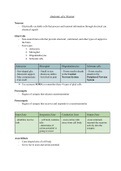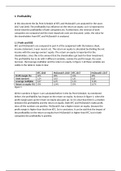Exam: 60%
› Lectures and literature → article + book
› Application of knowledge (to discuss and understand, make linkages)
› Open essay questions
Assignment (40%)
Argumentative essay, 2,500 words → see grading rubric in PPT 1!
➔ Billie: I extend the word count for your group to 2,800 (instead of 2,500) words. Please
indicate this agreement clearly on the title page of your assignment.
Wells – capability approach:
The Capability Approach is defined by its choice of focus upon the moral significance of individuals’
capability of achieving the kind of lives they have reason to value. This distinguishes it from more
established approaches to ethical evaluation, such as utilitarianism or resourcism, which focus
exclusively on subjective well-being or the availability of means to the good life, respectively. A
person’s capability to live a good life is defined in terms of the set of valuable ‘beings and doings’ like
being in good health or having loving relationships with others to which they have real access.
Here ‘poverty’ is understood as deprivation in the capability to live a good life, and ‘development’ is
understood as capability expansion.
Sen’s concerns about contemporary approaches to the evaluation of well-being:
1. Individuals can differ greatly in their abilities to convert the same resources into valuable
functionings (‘beings’ and ‘doings’). Therefore, evaluation that focuses only on means,
without considering what particular people can do with them, is insufficient.
2. People can internalize the harshness of their circumstances so that they do not desire what
they can never expect to achieve. This is the phenomenon of ‘adaptive preferences’ in which
people who are objectively very sick may, still declare, and believe, that their health is fine.
Therefore, evaluation that focuses only on subjective mental metrics is insufficient without
considering whether that matches with what a neutral observer would perceive as their
objective circumstances.
3. Whether or not people take up the options they have, the fact that they do have valuable
options is significant. Therefore evaluation must be sensitive to both actual achievements
(‘functionings’) and effective freedom (‘capability’).
4. Reality is complicated and evaluation should reflect that complexity rather than take a short-
cut by excluding all sorts of information from consideration in advance. Therefore, evaluation
of how well people are doing must seek to be as open-minded as possible.
Economics has a branch explicitly concerned with ethical analysis (‘Welfare Economics’). Sen’s
systematic criticism of the form of utilitarianism behind welfare economics identifies and rejects
each of its three pillars:
- Act consequentialism: actions should be assessed only in terms of the goodness or badness
of their consequences, this excludes any consideration of the morality of the process by
which consequences are brought about.
- Welfarism: the view that goodness should be assessed only in terms of subjective utility. Sen
argues that welfarism exhibits both ‘valuational neglect’ and ‘physical condition neglect’.
- Sum-ranking: focuses on maximizing the total amount of welfare in a society without regard
for how it is distributed, although this is generally felt to be important by the individuals
concerned.
1
,Resourcism is defined by its neutrality about what constitutes the good life. It therefore assesses how
well people are doing in terms of their possession of the general purpose resources necessary for the
construction of any particular good life.
The Capability Approach focuses directly on the quality of life that individuals are actually able to
achieve. This quality of life is analyzed in terms of the core concepts of ‘functionings’ (states of ‘being
and doing’) and ‘capability’ (set of valuable functionings that a person has effective access to).
Resources (such as a bicycle) are considered as an input, but their value depends upon individuals’
ability to convert them into valuable functionings (such as bicycling), which depends, on their
personal physiology (such as health), social norms, and physical environment (such as road quality).
An individual’s capability set is the set of valuable functionings that an individual has real access to.
Achieved functionings are those they actually select.
Sen argues that the correct focus for evaluating how well off people are is their capability to live a life
we have reason to value, not their resource wealth or subjective well-being. But in order to begin to
evaluate how people are performing in terms of capability, we first need to determine which
functionings matter for the good life and how much, or at least we need to specify a valuation
procedure for determining this.
The value of a capability set represents a person’s effective freedom to live a valuable life in terms of
the value of the functionings available to that individual, when the available functionings are
improved, so is the person’s effective freedom.
Examine the underlying determinants of the relationship between people and commodities,
including the following (Sen, 1999):
(1) Individual physiology, such as the variations associated with illnesses, disability, age, and gender.
Note that some of these disadvantages, such as blindness, may not be fully ‘correctable’ even with
tailored assistance.
(2) Local environment diversities, such as climate, epidemiology, and pollution. These can impose
particular costs such as more or less expensive heating or clothing requirements.
(3) Variations in social conditions, such as the provision of public services such as education and
security, and the nature of community relationships, such as across class or ethnic divisions.
(4) Differences in relational perspectives. Conventions and customs determine the commodity
requirements of expected standards of behaviour and consumption, so that relative income poverty
in a rich community may translate into absolute poverty in the space of capability.
(5) Distribution within the family – distributional rules within a family determining, for example, the
allocation of food and health-care between children and adults, males and females.
Applying:
The concept of a capability has a global-local character in that its definition abstracts from particular
circumstances, but its realization depends on specific local requirements. This makes the Capability
Approach applicable across political, economic, and cultural borders.
Capability evaluation is informationally demanding and its precision is limited by the level of
agreement about which functionings are valuable.
Highest benefits for the most amount of people.
Take distance from what people proclaim, sociology aspect. Opinions differ under different
circumstances.
2
,Lecture 2 - Guest Lecture – Pieter Boele van Hensbroek
Critique of science of economics
Current criticisms:
- Fails to predict crises
- Fails to provide working advise
- Fails to locate systems failures
- Always advises more market (deregulation), private property
Sen redefines the discipline (he is quantitative, but realistic, pro-poor). He revives Welfare
Economics.
Homo Economicus
• abstract view of human actors
• formal models far away from actual practice
The rational agent is assumed to take full account of available information, and potential costs and
benefits. (Idea: maximize self-interest = ‘human nature’ ?)
The behavior of individual actors conditions social outcomes.
Rational choice theory (also known as choice theory or rational action theory) is a framework for
understanding and formally modelling social and economic behaviour.
Better: Welfare Economics
Public Economics: the study of how government might intervene to improve social welfare.
= rank economically feasible allocations of resources in terms of the social welfare they entail.
• Public choices matter! (institutions, policy etc.)
• Like John Rawls: a ‘just society’ requires a just distribution of material goods
Example: Kerala state in India (>Have to get rid of the normal measurement approach)
Poor but ‘developed’!
• low infant mortality and population growth, and high levels of literacy and life expectancy
• wealth and resource redistribution programmes
• political participation and activism among ordinary people
Criticisms of focus on Wealth and Economic Growth
Economic growth does NOT measure:
- Distribution of wealth in the population
- Goods and services that are not marketed / priced
- Prices can be imperfect and manipulated / ‘politicized’ (net support of government to
resource exploitation in f.e. oil industry. Not free market prices, good if in advantage of the
people)
BUT: wealth/ opulence = intermediary good (focus on money, this is a bad indicator. Measure real
numbers in food, health, etc.)
The ultimate good = GOOD LIVING/ Human Development
“the nature of the life that people succeed in living”
Basic Needs – Pro-poor growth
For instance: Basic Income –the Brasilian Bolsa Familia program 2004
- Poverty in Brazil fell 27.7% during the first term in the Lula admin.
- About 12 million Brazilian families receive Bolsa funds
- By 2011, 26% of the Brazilian population
- World Bank report: people spend this money, in order of priority, on food, school supplies,
clothing, and shoes. (not like expectations, drinking etc.)
3
, Human Development Index
- UNDP 1990: to design a rough measure to replace GDP
- Mahbub Ul Haq: “… development is to create an enabling environment for people to enjoy
long, healthy and creative lives.”
HDI dimensions
• Health – e.g. Life expectancy at birth
• Education – e.g. Adult literacy; educational enrolment
• Income – e.g. GDP per capita; income equality
➔ What is missing here? Freedom (of choice). Democracy used to be the 4th indicator, political
participation not supported by many countries.
NEW INDICES
• Inequality adjusted HDI
• Gerder Inequality Index
• Gender Empowerment Measure
• Multidimensional Poverty Index
- GINI coefficient for measuring inequality (measures difference in highest and lowest 10%)
F.E.: if your average is okay, but woman are consistently lower, something is wrong. If you let 10%
work really hard in unhealthy circumstances, the other 90% will be okay but something is wrong.
2017 inequality-adjusted HDI (IHDI):
Japan pops up in top 3, Hong Kong nowhere to be found in comparison to HDI 7th place.
Age marriage strong relation with educational achievement.
4

